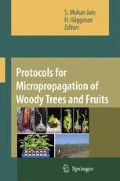Sequoia sempervirens (Lamb.) Endl., coast redwood, is a long-lived evergreen gymnosperm belonging to the family Taxodiaceae. This species is endemic to the coastal regions of California and Oregon, USA (Srinivasan & Friis, 1989; Ma et al., 2005). The fossil records of the genus Sequoia can be traced back to the Jurassic Period, in China (Endo, 1951). The tree is characterized by a thick, fibrous, and deeply furrowed bark along with a fire-resistant reddish-brown heartwood. Leaves of S. sempervirens are dimorphic, including linear and scale-like leaves. The linear leaves are spirally arranged or occasionally sub-opposite (Ma et al., 2005). The tree is highly valuable not only for ornamental purposes as trees can grow up to 110 m in length, but also for industrial purposes as it grows quite vigorously, rarely suffers from disease or insect attack, and it is resistant to strong winds and other poor climatic conditions. It is the high longevity and size of Sequoia trees that allow for its substantial biomass accumulation (Busing & Fujimori, 2005). In some stands, it exceeds 3500 metric tons/hectar. Thus, S. sempervirens can be used in the timber industry (plywood), paper industry, as well as pulp industry. It is well suited for short rotation coppicing.
Access this chapter
Tax calculation will be finalised at checkout
Purchases are for personal use only
Preview
Unable to display preview. Download preview PDF.
References
Ahuja, M.R., Devey, M.E., Groover, A.T., Jermstad, K.D. & Neale, D.B. (2004) Mapped DNA probes from loblolly pine can be used for restriction fragment length polymorphism mapping in other conifers. Theor. Appl. Genet. 88, 279-282.
Ali, I.F., Neale, D.B. & Marshall, K.A. (1991) Chloroplast DNA restriction fragment length poly- morphism in Sequoia sempervirens D. Don Endl., Pseudotsuga menziesii (Mirb.) Franco, Calocedrus decurrens (Torr.), and Pinus taeda L. Theor. Appl. Genet. 81, 83-89.
Arnaud, Y., Franclet, A., Tranvan, H. & Jacques, M. (1993) Micropropagation and rejuvenation of Sequoia sempervirens (Lamb) Endl: A review. Ann Sci. For. 50, 273-295.
Attree, S.M. & Fowke, L.C. (1993) Embryogeny of gymnosperms: advances in synthetic seed technology of conifers. Plant Cell Tiss Org. Cult. 35, 1-35.
Ball, E.A. (1987) Tissue culture multiplication of Sequoia. In: Bonga, J.M. & Durzan, D.L. (Eds) Cell and Tissue Culture in Forestry, vol 3. Martinus Nijhoff, Dordrecht, pp. 146-158.
Bourgkard, F. & Favre, J.M. (1988) Somatic embryos from callus of Sequoia sempervirens. Plant Cell Rep. 7, 445-448.
Busing, R.T. & Fujimori, T. (2005) Biomass, production and woody detritus in an old coast redwood (Sequoia sempervirens) forest. Plant Ecol. 177, 177-188.
Endo, S. (1951) A record of Sequoia from the Jurassic of Manchuria. Bot. Gazette 113, 228-230.
Fouret, Y., Larrieu, C. & Arnaud, Y. (1988) Rajeunissement in vitro chez la Sequoia sempervirens (Endl.). Ann Rech Sylv, AFOCEL, pp. 55-82.
Hizume, M., Kondo, T., Shibata, F. & Ishizuka, R. (2001) Flow cytometric determination of genome size in the Taxodiaceae, Cupressaceae sensu stricto and Sciadopityaceae. Cytologia 66, 307-331.
Liu, C, Xia, X., Yin, W., Huang, L. & Zhou, J. (2006) Shoot regeneration and somatic embryogenesis from needles of redwood (Sequoia sempervirens (D.Don.) Endl.). Plant Cell Rep. 25, 621-628.
Ma, Q.-W., Li, F.L. & Li, C.-S. (2005) The coast redwoods (Sequoia, Taxodiaceae) from the Eocene of Heilongjiang and the Miocene of Yunnan, China. Rev. Palaeobot. Palynol. 135, 117-129.
Pullman, G.S., Zhang, Y. & Phan, B.H. (2003) Brassinolide improves embryogenic tissue initiation in conifers and rice. Plant Cell Rep. 22, 96-104.
Rogers, D.L. (1999) Allozyme polymorphisms discriminate among coast redwood (Sequoia sempervirens) siblings. J. Hered. 90, 429-433.
Schenk, H. & Hildebrandt, A.C. (1972) Medium and techniques for induction and growth of mono- cotyledonous and dicotyledonous plant cell cultures. Can. J. Bot. 50, 199-204.
Srinivasan, V. & Friis, E.M. (1989) Taxodiaceous conifers from the Upper Cretaceous of Sweden. Biol. Skr. 35, 5-57.
Staba, E.J. (1969) Plant tissue culture as a technique for the phytochemist. Recent Adv. Phytochem. 2, 75-102.
Stasolla, C. & Yeung, E.C. (2003) Recent advances in conifer somatic embryogenesis: Improving somatic embryo quality. Plant Cell Tiss. Org. Cult. 74, 15-35.
Sul, I.-W. & Korban, S.S. (1994) Effect of different cytokinins on axillary shoot proliferation and elongation of several genotypes of Sequoia sempervirens. In Vitro Cell. Dev. Biol. 30P, 131-135.
Sul, I.-W. & Korban, S.S. (2005) Direct shoot organogenesis from needles of three genotypes of Sequoia sempervirens. Plant Cell Tiss. Org. Cult. 80, 353-358.
Wolter, K.E. & Skoog, F. (1966) Nutritional requirements of Fraxinus callus cultures. Am. J. Bot. 53, 263-269.
Author information
Authors and Affiliations
Editor information
Editors and Affiliations
Rights and permissions
Copyright information
© 2007 Springer
About this chapter
Cite this chapter
Korban, S.S., Sul, I.W. (2007). Micropropagation of Coast Redwood (Sequoia Sempervirens). In: Jain, S.M., Häggman, H. (eds) Protocols for Micropropagation of Woody Trees and Fruits. Springer, Dordrecht. https://doi.org/10.1007/978-1-4020-6352-7_3
Download citation
DOI: https://doi.org/10.1007/978-1-4020-6352-7_3
Publisher Name: Springer, Dordrecht
Print ISBN: 978-1-4020-6351-0
Online ISBN: 978-1-4020-6352-7
eBook Packages: Biomedical and Life SciencesBiomedical and Life Sciences (R0)

